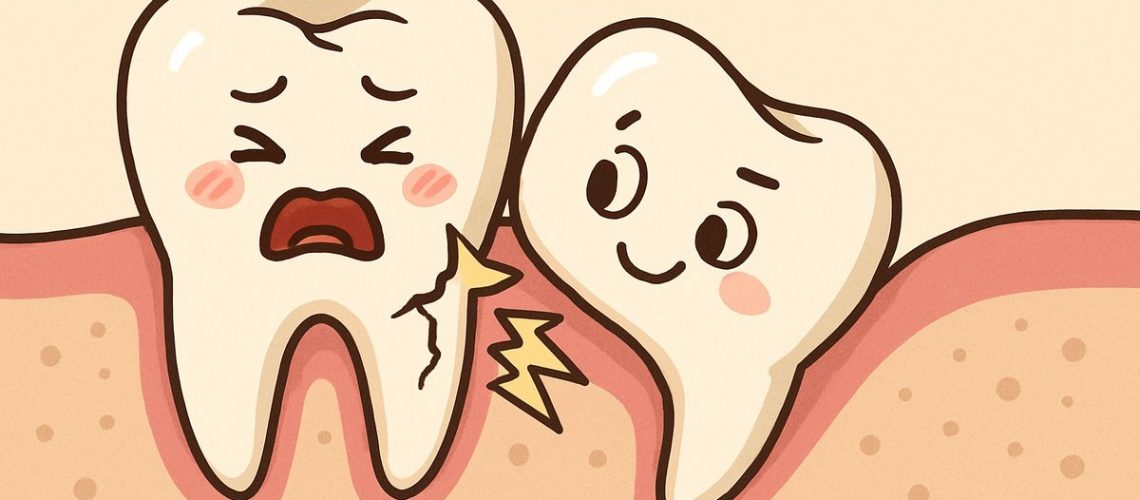When wisdom teeth grow in sideways, it can cause pain, infection, and damage to nearby teeth. This article explains what it means when wisdom teeth grow in sideways, common symptoms to watch for, how dentists decide whether removal is needed, what to expect during extraction and recovery, and when to get urgent care. If you live in Western PA, you’ll also learn why seeing a specialist at an oral‑facial surgery center can matter for complex cases.
What it means when wisdom teeth grow in sideways
When a wisdom tooth grows in sideways it is usually impacted or angled and cannot erupt normally. Impacted teeth can come in at several angles. Mesioangular impaction tilts forward toward the front teeth. Horizontal impaction lies nearly flat and pushes directly into the adjacent molar. These differ from normal eruption where the tooth comes up vertically through the gum and into alignment with other teeth. Sideways growth raises risk for infection, decay, and crowding.
Common symptoms when a wisdom tooth grows in sideways
Pain, swelling, and infection
Pain around the back molars, gum swelling, bad taste, or recurring jaw soreness are common. Food and bacteria can trap around a partially erupted sideways tooth, leading to pericoronitis (gum infection) or an abscess.
Damage to adjacent teeth and crowding
A sideways wisdom tooth can press on the neighboring second molar, causing decay, root damage, or bone loss. It may also contribute to crowding or shifting of your bite over time.
Asymptomatic but risky findings
Some people have no symptoms even when a tooth grows sideways. X‑rays may reveal decay on the adjacent tooth, cysts, or bone changes. Asymptomatic problems can worsen, so observation alone may not be safe long term.
How dentists determine if removal is needed
Clinical exam and X‑rays
Your surgeon will do a mouth exam and take panoramic or periapical X‑rays to see the angle, depth, and relationship to nearby roots and nerves. These images guide the treatment plan.
When advanced imaging (CT) is recommended
CT scans give a 3‑D view when a sideways wisdom tooth is close to nerves or the sinus, or if prior X‑rays are unclear. CT helps plan safer, more precise surgery.
Cases where monitoring is okay vs immediate extraction
If a sideways tooth shows no decay, no pressure on adjacent teeth, and no infection, careful monitoring may be chosen. Immediate extraction is usually advised for recurrent infections, damage to adjacent teeth, or risk to overall oral health.
What to expect during extraction and recovery
Simple extraction vs surgical removal
If the tooth is fully erupted and accessible, a simple extraction may work. Most sideways wisdom teeth require surgical removal: an incision, bone removal, and sectioning the tooth into pieces.
Anesthesia and sedation options
Local anesthesia plus nitrous oxide, oral sedation, or IV sedation is available. IV sedation keeps you comfortable for longer or more complex procedures.
Typical recovery timeline and home care
Expect swelling and mild to moderate pain for 2–4 days, with most healing in two weeks. Follow ice, soft diet, pain control, and oral hygiene instructions. Avoid straws and smoking until healed.
Why choose a specialized oral‑facial surgery center for complex sideways wisdom teeth
For patients in Western PA whose wisdom teeth grow in sideways, a specialty center offers CT‑guided planning, full anesthesia options, and surgeons experienced with difficult anatomy. At New Smile Now, Dr. Ryan McCloy focuses on wisdom‑teeth and oral surgery and uses advanced technology and IV sedation to improve safety and comfort for complex extractions.
Complications and next steps if adjacent teeth are lost
If a sideways tooth damages or causes loss of an adjacent molar, implant solutions are an option. Dr. Edward Halusic at New Smile Now specializes in implants and full‑arch restorations to replace missing teeth and restore function.
When to call your surgeon
Seek immediate care for severe pain not controlled by medication, heavy bleeding, fever, difficulty breathing or swallowing, or swelling that spreads to the neck or eyes. A specialist evaluation can determine the safest plan when wisdom teeth grow in sideways. For expert assessment and CT‑guided planning, contact New Smile Now to schedule a consultation with Dr. McCloy at their Greensburg or Monroeville locations.

